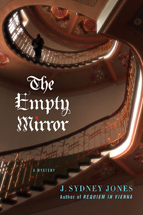 Peter Lovesey needs little introduction to aficionados of crime fiction. Known for his Victorian-era police procedurals featuring Sergeant Cribb written during the 1970s and a staple on British television in the 1980s, Lovesey now pens a series featuring Peter Diamond, a modern-day police detective in Bath. But Lovesey has also written a score of other works of fiction and nonfiction, some under the pseudonym of Peter Lear.
Peter Lovesey needs little introduction to aficionados of crime fiction. Known for his Victorian-era police procedurals featuring Sergeant Cribb written during the 1970s and a staple on British television in the 1980s, Lovesey now pens a series featuring Peter Diamond, a modern-day police detective in Bath. But Lovesey has also written a score of other works of fiction and nonfiction, some under the pseudonym of Peter Lear.
Of his 2011 Diamond novel, Stagestruck,  Marilyn Stasio dubbed it a “brilliantly conceived and smartly executed mystery set in the hallowed Theater Royal of Bath,” in the New York Times Book Review. Of that same work, Publishers Weekly noted, “Lovesey proves he has few peers as a crafter of contemporary fair-play whodunits.” His newest Diamond novel, Cop to Corpse, is just out from Soho, and Publishers Weekly had glowing words in its starred review: “Nail-biting…. Lovesey leavens the suspense with Diamond’s trademark gallows humor, and closes with one of his cleverest solutions.”
Marilyn Stasio dubbed it a “brilliantly conceived and smartly executed mystery set in the hallowed Theater Royal of Bath,” in the New York Times Book Review. Of that same work, Publishers Weekly noted, “Lovesey proves he has few peers as a crafter of contemporary fair-play whodunits.” His newest Diamond novel, Cop to Corpse, is just out from Soho, and Publishers Weekly had glowing words in its starred review: “Nail-biting…. Lovesey leavens the suspense with Diamond’s trademark gallows humor, and closes with one of his cleverest solutions.”
 Lovesey has won just about every writing prize that is out there, including the CWA Macallan Silver Dagger and Gold Dagger, the Barry Award, the Macavity Award, the Anthony Award, the Ellery Queen Readers’ Award–well, you get the idea. The New York Times Book Review dubbed him a “master of the classic puzzle,” and the Wall Street Journal noted that “Lovesey’s delicate balance of humor and suspense [is] one of the delights of contemporary crime fiction.”
Lovesey has won just about every writing prize that is out there, including the CWA Macallan Silver Dagger and Gold Dagger, the Barry Award, the Macavity Award, the Anthony Award, the Ellery Queen Readers’ Award–well, you get the idea. The New York Times Book Review dubbed him a “master of the classic puzzle,” and the Wall Street Journal noted that “Lovesey’s delicate balance of humor and suspense [is] one of the delights of contemporary crime fiction.”
Peter, it is an honor and delight to have you with us at Scene of the Crime. You know the drill–let’s start things off with a discussion of your crime scene. (more…)







